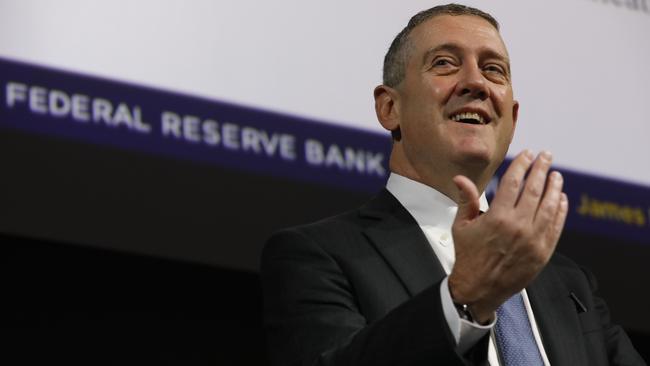As Ukraine tensions cool, Federal Reserve back in focus
Easing Ukraine tensions were a welcome respite but the focus of global markets now turns back to the US Federal Reserve.

Easing Ukraine tensions were a welcome respite after a choppy start to the week but the focus of global markets now turns back to the more important question of how rapidly the Federal Reserve will tighten monetary policy after it ends quantitative easing next month.
Helped by decent earnings reports and outlook statements from the likes of CSL, Treasury Wines and Vicinity Centres, Australia’s S&P/ASX 200 index added 1.1 per cent after solid gains overseas.
But even if an invasion of Ukraine and a consequent energy price shock and other disruptions of stretched supply chains are avoided, risky assets including shares and the Aussie dollar could still come under fire if it turns out that the hawkish stance of St Louis Fed president James Bullard after last week’s blowout US inflation data prove to be more of a mainstream view within the Fed.
Minutes of the recent Federal Reserve meeting will be scrutinised on Thursday.
As JP Morgan strategists outlined this week, the risk of conflict in Ukraine is high and it certainly wouldn’t be out of the question for such a conflict to prompt a “dovish reassessment” of monetary policy tightening plans by major central banks including the Fed and European Central Bank.
But such reassessments usually come in response to financial markets reactions.
The question is: at what levels of prices for sharemarkets and energy do central banks blink?
BofA’s February Global Fund Manager Survey of 314 respondents managing $US1 trillion ($1.4 trillion) found the consensus was that the “Fed put” option – the level of the S&P 500 at which the Fed will respond by lessening its policy tightening plans – is 3700 points. That’s 17 per cent below the current level and 12 per cent below the January “correction” trough.
Interestingly, 3700 points on the S&P 500 would mark a 22 per cent fall from the record high.
That would put the index well into “bear market” territory for the first time since the Covid-19 panic at the start of the pandemic, which saw some of the briefest of bear markets of all time due to unprecedented policy support, particularly from the Fed.
BofA’s chief investment strategist Michael Hartnett said that while investors were overall “bearish” with the average cash reserve jumping to 5.3 per cent, they’re “not extremely bearish”.
For example, survey respondents on the whole remain long cyclical stocks versus bonds.
“We remain negative on credit and stock returns in (calendar year) 2022 as we believe fund manager survey investor probabilities of a credit event, recession and bear market are too low,” he said.
A key point of difference between now and 2020, and the reason why some argue that the S&P 500 is more likely to retest its January low from here rather than make a new record high as it did after the brief bear market of February-March 2020, is that the Fed won’t be constantly dialling up its monetary policy support to the mammoth levels it did two years ago.
It is true that the pandemic is easing, the global economy is reopening and above-trend growth is expected outside of China, and even China has started easing while others tighten.
In early 2020 investors faced the prospect of rolling outbreaks and lockdowns.
But in a world of zero interest rates and potentially unlimited and open-ended quantitative easing by the world’s central banks, it could be argued that monetary policy liquidity trumps all.
If that’s the case, investors may want to “trade the interventions” to some extent, rather than bet too much on sustained economic growth due in no small way to those interventions.
In this case, it means taking less risk in financial markets as some of the policy support is withdrawn.
Of course it remains to be seen if all the tough talk from Fed officials including chairman Jay Powell and Bullard actually means a rapid tightening of monetary policy is imminent.
If the Fed was really serious, one would think they would wrap up QE earlier.





To join the conversation, please log in. Don't have an account? Register
Join the conversation, you are commenting as Logout